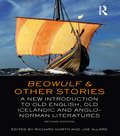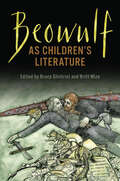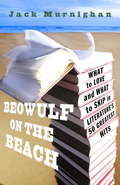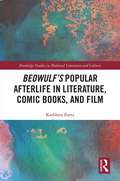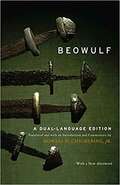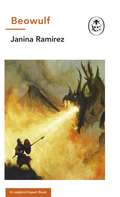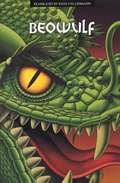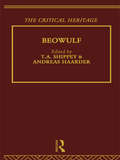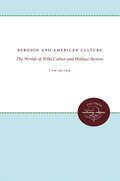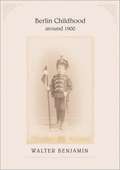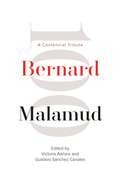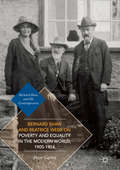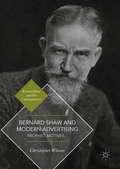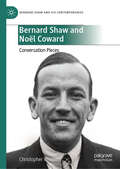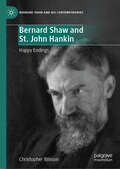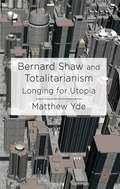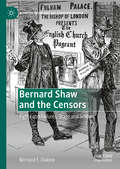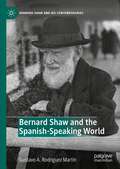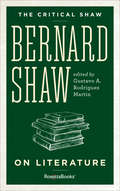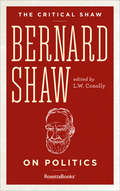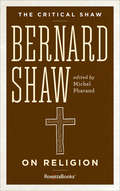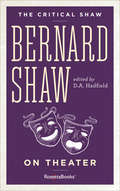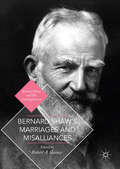- Table View
- List View
Beowulf and Other Stories: A New Introduction to Old English, Old Icelandic and Anglo-Norman Literatures
by Joe Allard Richard NorthBeowulf & Other Stories was first conceived in the belief that the study of Old English – and its close cousins, Old Icelandic and Anglo-Norman – can be a genuine delight, covering a period as replete with wonder, creativity and magic as any other in literature. Now in a fully revised second edition, the collection of essays written by leading academics in the field is set to build upon its established reputation as the standard introduction to the literatures of the time. Beowulf & Other Stories captures the fire and bloodlust of the great epic, Beowulf, and the sophistication and eroticism of the Exeter Riddles. Fresh interpretations give new life to the spiritual ecstasy of The Seafarer and to the imaginative dexterity of The Dream of the Rood, andprovide the student and general reader with all they might need to explore and enjoy this complex but rewarding field. The book sheds light, too, on the shadowy contexts of the period, with suggestive and highly readable essays on matters ranging from the dynamism of the Viking Age to Anglo-Saxon input into The Lord of the Rings, from the great religious prose works to the transition from Old to Middle English. It also branches out into related traditions, with expert introductions to the Icelandic Sagas, Viking Religion and Norse Mythology. Peter S. Baker provides an outstanding guide to taking your first steps in the Old English language, while David Crystal provides a crisp linguistic overview of the entire period. With a new chapter by Mike Bintley on Anglo-Saxon archaeology and a revised chapter by Stewart Brookes on the prose writers of the English Benedictine Reform, this updated second edition will be essential reading for students of the period.
Beowulf as Children’s Literature
by Bruce Gilchrist and Britt MizeThe single largest category of Beowulf representation and adaptation, outside of direct translation of the poem, is children’s literature. Over the past century and a half, more than 150 new versions of Beowulf directed to child and teen audiences have appeared, in English and in many other languages. In this collection of original essays, Bruce Gilchrist and Britt Mize examine the history and processes of remaking Beowulf for young readers. Inventive in their manipulations of story, tone, and genre, these adaptations require their authors to make countless decisions about what to include, exclude, emphasize, de-emphasize, and adjust. This volume considers the many forms of children’s literature, focusing primarily on picture books, illustrated storybooks, and youth novels, but taking account also of curricular aids, illustrated full translations of the poem, and songs. Contributors address issues of gender, historical context, war and violence, techniques of narration, education, and nationalism, investigating both the historical and theoretical dimensions of bringing Beowulf to child audiences.
Beowulf on the Beach: What to Love and What to Skip in Literature's 50 Greatest Hits
by Jack MurnighanFrom Homer and Proust to "Beloved" and the Bible, "Beowulf on the Beach" is a user-friendly guide through the imposing world of literature.
Beowulf's Popular Afterlife in Literature, Comic Books, and Film
by Kathleen ForniBeowulf's presence on the popular cultural radar has increased in the past two decades, coincident with cultural crisis and change. Why? By way of a fusion of cultural studies, adaptation theory, and monster theory, Beowulf's Popular Afterlife examines a wide range of Anglo-American retellings and appropriations found in literary texts, comic books, and film. The most remarkable feature of popular adaptations of the poem is that its monsters, frequently victims of organized militarism, male aggression, or social injustice, are provided with strong motives for their retaliatory brutality. Popular adaptations invert the heroic ideology of the poem, and monsters are not only created by powerful men but are projections of their own pathological behavior. At the same time there is no question that the monsters created by human malfeasance must be eradicated.
Beowulf: A Dual-Language Edition
by Howell D. ChickeringThe first major poem in English literature, Beowulf tells the story of the life and death of the legendary hero Beowulf in his three great battles with supernatural monsters. The ideal Anglo-Saxon warrior-aristocrat, Beowulf is an example of the heroic spirit at its finest. <p><p> Leading Beowulf scholar Howell D. Chickering, Jr.’s, fresh and lively translation, featuring the Old English on facing pages, allows the reader to encounter Beowulf as poetry. This edition incorporates recent scholarship and provides historical and literary context for the modern reader.
Beowulf: A Ladybird Expert Book (The Ladybird Expert Series #26)
by Janina RamirezPart of the ALL-NEW LADYBIRD EXPERT SERIES'This accessible illustrated guide is a great introduction to the story, its origins and its enduring legacy' BBC HISTORY- Which is more terrifying - a monster or its mother? - Why did Berserkers run naked into battle? - How was the story of Beowulf almost lost forever?PLUNGE into the adventures of Beowulf, the 6th Century hero who defeated the monster Grendel, became king of his people, and slayed a tremendous dragon. Surviving in a single, burnt manuscript, Beowulf continues to entrance readers and inspire major works of fantasy today.WARRIORS. MONSTERS. DRAGONS. GOLD.Janina Ramirez's Beowulf is an accessible and authoritative guide to the spellbinding world and daring feats of a poem remembered through the centuries.
Beowulf: An Imitative Translation
by Ruth P. M. LehmannThe name "Beowulf" lingers in our collective memory, although today fewer people have heard the tale of the Germanic hero's fight with Grendel, the dreadful Monster of the Mere, as recounted in this Anglo-Saxon epic. This edition of Beowulf makes the poem more accessible than ever before. Ruth Lehmann's imitative translation is the only one available that preserves both the story line of the poem and the alliterative versification of the Anglo-Saxon original. The characteristic features of Anglo-Saxon poetry- alliterative verse with first-syllable stress, flexible word order, and inflectional endings-have largely disappeared in Modern English, creating special problems for the translator. Indeed, many other translations of Beowulf currently available are either in prose or in some modern poetic form. Dr. Lehmann's translation alone conveys the "feel" of the original, its rhythm and sound, the powerful directness of the Germanic vocabulary. In her introduction, Dr. Lehmann gives a succinct summary of the poem's plot, touching on the important themes of obligation and loyalty, of family feuds, unforgivable crimes, the necessity of revenge, and the internal and external struggles of the Scandinavian tribes. She also describes the translation process in some detail, stating the guiding principles she used and the inevitable compromises that were sometimes necessary.
Beowulf: Contexts, Criticism
by E. Talbot Donaldson Nicholas HoweThe text of this edition of "Beowulf" is based on the highly regarded Donaldson prose translation of the Anglo-Saxon epic poem.
Beowulf: The Critical Heritage (Critical Heritage Ser.)
by T. A. Shippey Andreas HaarderBeowulf is the oldest and most complete epic poem in any non-Classical European language. Our only manuscript, written in Old English, dates from close to the year 1000. However, the poem remained effectively unknown even to scholars until the year 1815, when it was first published in Copenhagen. This impressive volume selects over one hundred works of critical commentary from the vast body of scholarship on Beowulf - including English translations from German, Danish, Latin and Spanish - from the poem's first mention in 1705 to the Anglophone scholarship of the early twentieth century. Tom Shippey provides both a contextual introduction and a guide to the eighteenth- and nineteenth-century scholarship which generated these Beowulf commentaries. The book is a vital document for the study of one of the major texts of 'the Northern renaissance', in which completely unknown poems and even languages were brought to the attention first of the learned world and then of popular culture. It also acts as a valuable guide to the development of nationalist and racist sentiment, beginning romantically and ending with World War and attempted genocide.
Bergson and American Culture: The Worlds of Willa Cather and Wallace Stevens
by Tom QuirkBergsonian "vitalism" challenged the dominance of Spencerian determinism in the early twentieth century and seemed to offer a new foundation for belief in human freedom and individual possibility. Quirk traces the impact of Bergsonism upon the American sensibility and shows how individual writers -- particularly two such different artists as Willa Cather and Wallace Stevens -- appropriated vitalistic notions and made them serve the peculiar requirements of their own unique creative imaginations.Originally published in 1990.A UNC Press Enduring Edition -- UNC Press Enduring Editions use the latest in digital technology to make available again books from our distinguished backlist that were previously out of print. These editions are published unaltered from the original, and are presented in affordable paperback formats, bringing readers both historical and cultural value.
Berlin Childhood around 1900
by Walter Benjamin Howard EilandBerlin Childhood around 1900 remained unpublished during Walter Benjamin's lifetime. Now translated into English for the first time in book form, on the basis of the recently discovered final version that contains the author's own arrangement of a suite of luminous vignettes, it can be more widely appreciated as one of the masterpieces of twentieth-century prose writing. This book is also one of Benjamin's great city texts, bringing to life the cocoon of his childhood--the parks, streets, schoolrooms, and interiors of an emerging metropolis. It reads the city as palimpsest and labyrinth, revealing unexpected lyricism in the heart of the familiar.
Bernard Malamud: A Centennial Tribute
by Victoria Aarons Gustavo Sanchez CanalesMaster storyteller and literary stylist Bernard Malamud is considered one of the top three most influential postwar American Jewish writers, having established a voice and a presence for other authors in the literary canon. Along with Philip Roth and Saul Bellow, Malamud brought to life a decidedly American Jewish protagonist and a newly emergent voice that came to define American letters and that has continued to influence writers for over half a century. This collection is a tribute to Malamud in honor of the hundredth anniversary of his birth. Literary critic Harold Bloom suggests that “Malamud is perhaps the purest storyteller since Leskov,” the nineteenth-century Russian novelist and satirist. Novelist Cynthia Ozick, in a tribute to Malamud, described him as “the very writer who had brought into being a new American idiom of his own idiosyncratic invention.” Unlike other collections devoted to Malamud, this collection is international in scope, compiling diverse essays from the United States, France, Germany, Greece, and Spain, and demonstrating the wide range of scholarship and approaches to Bernard Malamud’s fiction. The essays show the breadth and depth of this masterful craftsman and explore through his short fiction and his novels such topics as the Malamudian protagonist’s relation to the urban/natural space; Malamud’s approach to death; race and ethnicity; the Malamudian hero as modern schlemiel; and the role of fantasy in Malamud’s fiction. Bernard Malamud is a comprehensive collection that celebrates a voice that helped to shape the last fifty years of literary works. Readers of American literary criticism and Jewish studies alike will appreciate this collection.
Bernard Shaw and Beatrice Webb on Poverty and Equality in the Modern World, 1905–1914 (Bernard Shaw and His Contemporaries)
by Peter GahanThis book investigates how, alongside Beatrice Webb's ground-breaking pre- World War One anti-poverty campaigns, George Bernard Shaw helped launch the public debate about the relationship between equality and democracy in a developed economy. The ten years following his great 1905 play on poverty Major Barbara present a puzzle to Shaw scholars, who have hitherto failed to appreciate both the centrality of the idea of equality in major plays like Getting Married, Misalliance, and Pygmalion, and to understand that his major political work, 1928's The Intelligent Woman's Guide to Socialism and Capitalism had its roots in this period before the Great War. As both the era's leading dramatist and leader of the Fabian Society, Shaw proposed his radical postulate of equal incomes as a solution to those twin scourges of a modern industrial society: poverty and inequality. Set against the backdrop of Beatrice Webb's famous Minority Report of the Royal Commission on the Poor Law 1905-1909 - a publication which led to grass-roots campaigns against destitution and eventually the Welfare State - this book considers how Shaw worked with Fabian colleagues, Sidney and Beatrice Webb, and H. G. Wells to explore through a series of major lectures, prefaces and plays, the social, economic, political, and even religious implications of human equality as the basis for modern democracy.
Bernard Shaw and Modern Advertising: Prophet Motives (Bernard Shaw and His Contemporaries)
by Christopher WixsonThis book charts how promotional campaigns in which Bernard Shaw participated were key crucibles within which agency and personality could re-negotiate their relationship to one another and to the consuming public. Concurrent with the rise of modern advertising, the creation of Shaw’s 'G.B.S.' public persona was achieved through masterful imitation of patent medicine marketing strategies and a shrewd understanding of the relationship between product and spokesman. Helping to enhance the visibility of his literary writing and dovetailing with his Fabian political activities, 'G.B.S.' also became a key figure in the evolution of testimonial endorsement and the professionalizing of modern advertising. The study analyzes multiple ad series in which Shaw was prominently featured that were occasions for self-promotion for both Shaw and the agencies, and presage the iconoclastic style of contemporary 'public personality' and techniques of celebrity marketing.
Bernard Shaw and Noël Coward: Conversation Pieces (Bernard Shaw and His Contemporaries)
by Christopher WixsonThis book tracks dramaturgical affinities between some of Bernard Shaw&’s late &“extravagant&” plays and those of Noël Coward, in particular their recasting of one another&’s style and the tradition of manners comedy. While Coward&’s first play (The Young Idea) all but plagiarizes You Never Can Tell and Shaw responds with his own depictions of the idle rich, their experimental plays in the 1930s also ambitiously engage issues of race and Empire, topics further outside their respective idioms. &“Christopher Wixson mines Shaw&’s rarely-explored engagement with the work of Noël Coward, examining both writers' highly experimental plays from the 1930s in light of such important issues as postwar disillusionment, racial difference, and post-coloniality.&” Michel Pharand, Queen's University
Bernard Shaw and St. John Hankin: Happy Endings (Bernard Shaw and His Contemporaries)
by Christopher Wixson&“This original study will no doubt draw attention to St. John Hankin&’s work, which may in turn receive further scrutiny from scholars, students, and theatre practitioners.&” Michel Pharand, Queen's University This book proposes a vibrant intertextual dialogue between St. John Hankin&’s manners comedies and what are considered Bernard Shaw&’s &“minor&” Edwardian comedies and, after the war, some of his most experimental &“extravagant&” plays. Engaging thematic topics ranging from philanthropy and parenting to marital alliances and comic endings, their dramaturgy was truly in conversation over form and content as they re-purposed one another in a vital wrangling to direct the creative evolution of modern British comedy.
Bernard Shaw and Totalitarianism Longing for Utopia
by Matthew YdeThis book reveals the genuity of Shaw's totalitarianism by looking at his material - articles, speeches, letters, etc but is especially concerned with analyzing the utopian desire that runs through so many of Shaw's plays; looking at his political and eugenic utopianism as expressed in his drama and comparing this to his political totalitarianism.
Bernard Shaw and the Censors: Fights and Failures, Stage and Screen (Bernard Shaw and His Contemporaries)
by Bernard F. Dukore“Dukore’s style is fluid and his wit delightful. I learned a tremendous amount, as will most readers, and Bernard Shaw and the Censors will doubtless be the last word on the topic.”- Michel Pharand, former editor of SHAW: The Journal of Bernard Shaw Studies and author of Bernard Shaw and the French (2001). "This book shows us a new side of Shaw and his complicated relationships to the powerful mechanisms of stage and screen censorship in the long twentieth century.” - - Lauren Arrington, Professor of English, Maynooth University, IrelandA fresh view of Shaw versus stage and screen censors, this book describes Shaw as fighter and failure, whose battles against censorship – of his plays and those of others, of his works for the screen and those of others – he sometimes won but usually lost. We forget usually, because ultimately he prevailed and because his witty reports of defeats are so buoyant, they seem to describe triumphs. We think of him as a celebrity, not an outsider; as a classic, not one of the avant-garde, of which Victorians and Edwardians were intolerant; as ahead of his time, not of it, when he was called “disgusting,” “immoral", and "degenerate.” Yet it took over three decades and a world war before British censors permitted a public performance of Mrs Warren’s Profession. We remember him as an Academy Award winner for Pygmalion, not as an author whose dialogue censors required deletions for showings in the United States. Scrutinizing the powerful stage and cinema censorship in Britain and America, this book focuses on one of its most notable campaigners against them in the last century.
Bernard Shaw and the Making of Modern Ireland (Bernard Shaw and His Contemporaries)
by Audrey McNamara Nelson O’Ceallaigh RitschelThis book is an anthology focused on Shaw’s efforts, literary and political, that worked toward a modernizing Ireland. Following Declan Kiberd’s Foreword and the editor’s Introduction, the contributing chapters, in their order of appearance, are from President of Ireland Michael D. Higgins, Anthony Roche, David Clare, Elizabeth Mannion, Nelson O’Ceallaigh Ritschel, Aisling Smith, Susanne Colleary, Audrey McNamara, Aileen R. Ruane, Peter Gahan, and Gustavo A. Rodriguez Martin. The essays establish that Shaw’s Irishness was inherent and manifested itself in his work, demonstrating that Ireland was a recurring feature in his considerations. Locating Shaw within the march towards modernizing Ireland furthers the recent efforts to secure Shaw’s place within the Irish spheres of literature and politics.
Bernard Shaw and the Spanish-Speaking World (Bernard Shaw and His Contemporaries)
by Gustavo A. Rodríguez MartínThis book explores, through a multidisciplinary approach, the immense influence exerted by Bernard Shaw on the Spanish-speaking world on both sides of the Atlantic. This collection of essays encompasses the reception and dissemination of his ideas; the translation of his works into Spanish; the performance history of his plays in Spain and Latin America; and Shaw’s influence on many key figures of literature in Spanish. It begins by delving into Shaw’s knowledge of Spanish literature and gauging his acquaintance with the Spanish cultural milieu throughout his tenure as an art, music, and theatre critic. His early exposure to Spanish-speaking culture later made the return trip in the form of profuse critical reception and theatrical success in countries like Spain, Argentina, Mexico, and Uruguay. This allows for a more detailed investigation into the unmistakable mark that Bernard Shaw left in the oeuvre of leading Spanish-speaking authors like Ramiro de Maeztu, Jorge Luis Borges or Nemesio Canales. This volume also assesses the translations of Shaw’s works into Spanish—while also providing a detailed publication history of these translations.
Bernard Shaw on Literature: On Literature (The Critical Shaw)
by George Bernard ShawA collection of literary criticism from the Nobel Prize–winning playwright behind such classics as Saint Joan and Pygmalion.The Critical Shaw: On Literature is a comprehensive selection of renowned Irish playwright and Nobel Laureate Bernard Shaw&’s ideas and opinions on a wide range of literary forms of expression, from Shakespearean drama to ghost stories, from naturalist novels to philosophical essays. Shaw meticulously applied his comprehensive knowledge of the intricacies of writing and publishing (composition, typesetting, style, themes, censorship) and in the process produced an extensive array of critical works spanning more than fifty years. Always with an axe to grind—whether aesthetic, ethical, or otherwise—Shaw tested the boundaries of satire in his critical essays, occasionally locking horns as a result with some of the most prominent authors of his lifetime. Displaying wit and wisdom in equal proportions, some of his reviews remain fresh even though the authors and books they appraised have long since fallen into oblivion. Shaw&’s views about literature challenged established conventions of the canon and helped to shape a renewed collective concept of literature.The Critical Shaw series brings together, in five volumes and from a wide range of sources, selections from Bernard Shaw&’s voluminous writings on topics that exercised him for the whole of his professional career: Literature, Music, Politics, Religion, and Theater. The volumes are edited by leading Shaw scholars, and all include an introduction, a chronology of Shaw&’s life and works, annotated texts, and a bibliography. The series editor is L.W. Conolly, literary adviser to the Shaw Estate and former president of the International Shaw Society.
Bernard Shaw on Politics: On Politics (The Critical Shaw)
by George Bernard ShawA collection of critical writings on politics from the Nobel Prize – winning playwright behind Saint Joan and Man and Superman. The Critical Shaw: On Politics is a comprehensive selection of renowned Irish playwright and Nobel Laureate Bernard Shaw&’s opinions on a wide range of political movements, ideologies, and events that helped shape the international landscape of the late nineteenth and early twentieth centuries. With unwavering conviction, and in many cases openly courting controversy and calumny, Shaw spoke his mind on the big &“-isms&” of his time: Socialism, Capitalism, Communism, and Fascism. He championed Socialism in its formative years, he condemned all combatants in the First World War, he berated America&’s embrace of Capitalism, he praised Russia&’s choice of Communism, he lauded Stalin, he rejected the notion that Hitler was responsible for the Second World War, and he scorned Democracy. Persistently provocative, sometimes outrageous, always the political iconoclast, Shaw's political convictions—as soapbox orator or world-famous pundit—challenge us to face the political issues and dilemmas of our own time with similar rigor and integrity.The Critical Shaw series brings together, in five volumes and from a wide range of sources, selections from Bernard Shaw&’s voluminous writings on topics that exercised him for the whole of his professional career: Literature, Music, Politics, Religion, and Theater. The volumes are edited by leading Shaw scholars, and all include an introduction, a chronology of Shaw&’s life and works, annotated texts, and a bibliography. The series editor is L.W. Conolly, literary adviser to the Shaw Estate and former president of the International Shaw Society.
Bernard Shaw on Religion: On Religion (The Critical Shaw)
by George Bernard ShawFrom the Nobel Prize–winning playwright behind Pygmalion and Saint Joan, a collection of his critical writings on religion.The Critical Shaw: On Religion is a comprehensive selection of renowned Irish playwright and Nobel Laureate Bernard Shaw&’s pronouncements—many of them deliberately inflammatory—on all facets of religion and belief: on Christianity and the Church; on various religions, among them Protestantism, Catholicism, Quakerism, Christian Science, Fundamentalism, Calvinism, Hinduism, Judaism, and Islam; on atheism and agnosticism, atonement and salvation; the crucifixion, the resurrection, transubstantiation, and the Immaculate Conception; on the Bible, the Ten Commandments, the Book of Common Prayer, and the Thirty-nine Articles of the Anglican Church. And much more. In speeches, essays, and prefaces, Shaw relentlessly scrutinized and critiqued scores of religions—only to find most of their doctrines in need of exhaustive reform. And yet, in keeping with his many other paradoxes, though Shaw was fond of calling himself an atheist, he nonetheless recognized the importance, indeed the necessity, of religion.The Critical Shaw series brings together, in five volumes and from a wide range of sources, selections from Bernard Shaw&’s voluminous writings on topics that exercised him for the whole of his professional career: Literature, Music, Politics, Religion, and Theater. The volumes are edited by leading Shaw scholars, and all include an introduction, a chronology of Shaw&’s life and works, annotated texts, and a bibliography. The series editor is L.W. Conolly, literary adviser to the Shaw Estate and former president of the International Shaw Society.
Bernard Shaw on Theater: On Theater (The Critical Shaw)
by George Bernard ShawA collection of critical writings on theater from the Nobel Prize–winning playwright behind Man and Superman and Pygmalion.The Critical Shaw: On Theater is a comprehensive selection of essays and addresses about drama and theater by renowned Irish playwright and Nobel Laureate Bernard Shaw. An outspoken critic of the melodramas and formulaic farces that comprised most of the popular theater in the late nineteenth century, Shaw relentlessly campaigned for audiences, actors, theater managers, and even government officials to take theater more seriously, to use the stage as a forum for representing complex real issues such as poverty, marriage and divorce laws, sexual attraction, gender equality, and political power, so that through seeing them acted out, audiences could better understand and address them when they left the theater. Shaw&’s commitment to social reform through theater was matched by his expertise in the artistic and practical aspects of drama: whether he was reviewing productions, lecturing about acting, or schooling agents on royalties and copyright law, Shaw set a standard for intelligent professionalism that our own theaters might still aspire to and be measured against.The Critical Shaw series brings together, in five volumes and from a wide range of sources, selections from Bernard Shaw&’s voluminous writings on topics that exercised him for the whole of his professional career: Literature, Music, Politics, Religion, and Theater. The volumes are edited by leading Shaw scholars, and all include an introduction, a chronology of Shaw&’s life and works, annotated texts, and a bibliography. The series editor is L.W. Conolly, literary adviser to the Shaw Estate and former president of the International Shaw Society.
Bernard Shaw's Marriages and Misalliances (Bernard Shaw and His Contemporaries)
by Robert A. GainesThis book combines the insights of thirteen Shavian scholars as they examine the themes of marriage, relationships and partnerships throughout all of Bernard Shaw's major works. It also connects Shaw's own experiences of love and marriage to the themes that emerge in his works, showing how his personal relationships in and out of matrimonial bonds change the ways his characters enter and exit marriages and misalliances. While providing a wealth of new analysis, this collection of essays also leaves lingering questions for the reader to spark continuing dialogue in both individual and academic settings.
